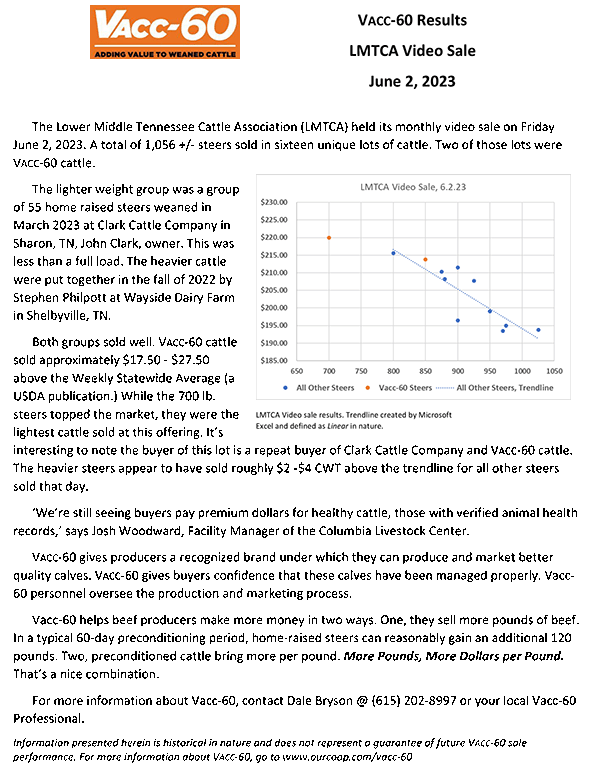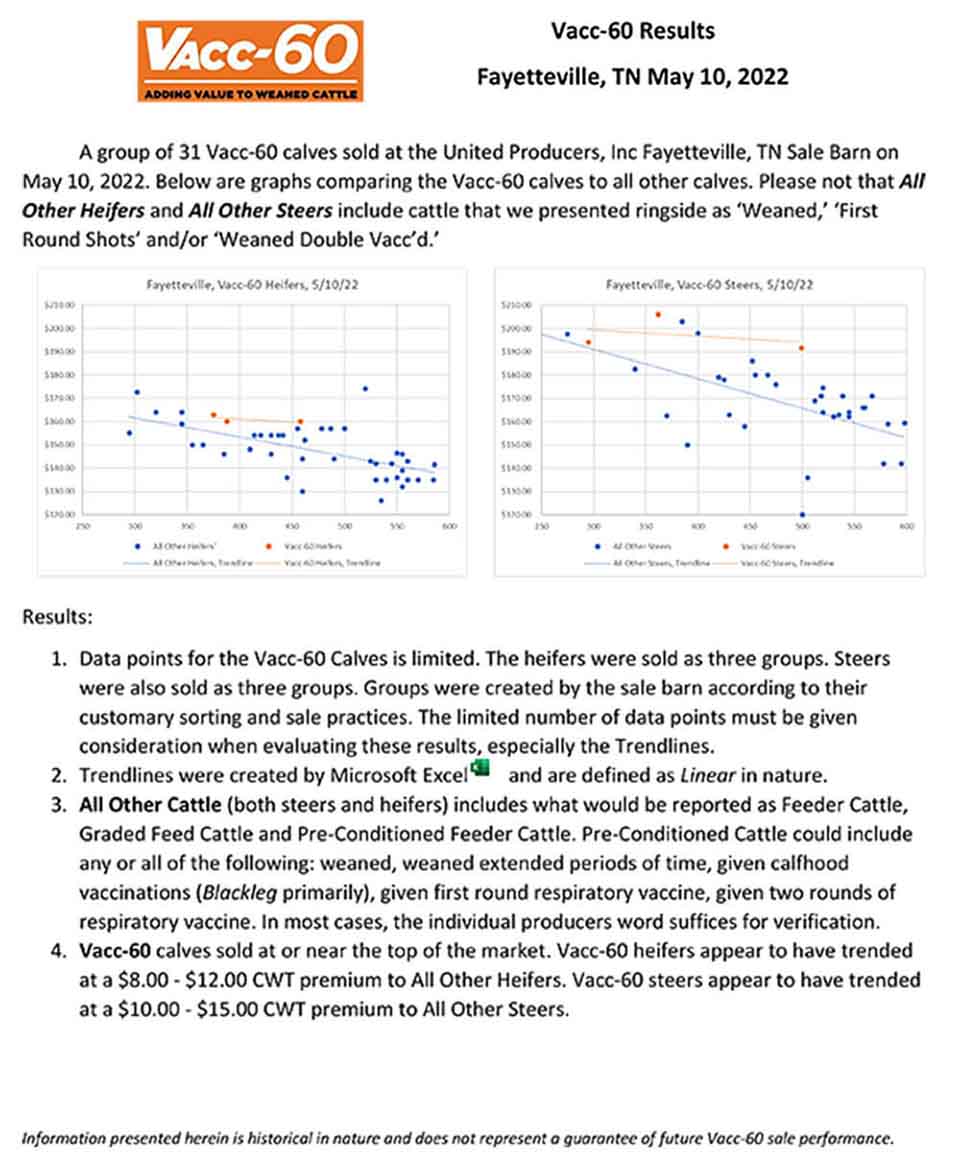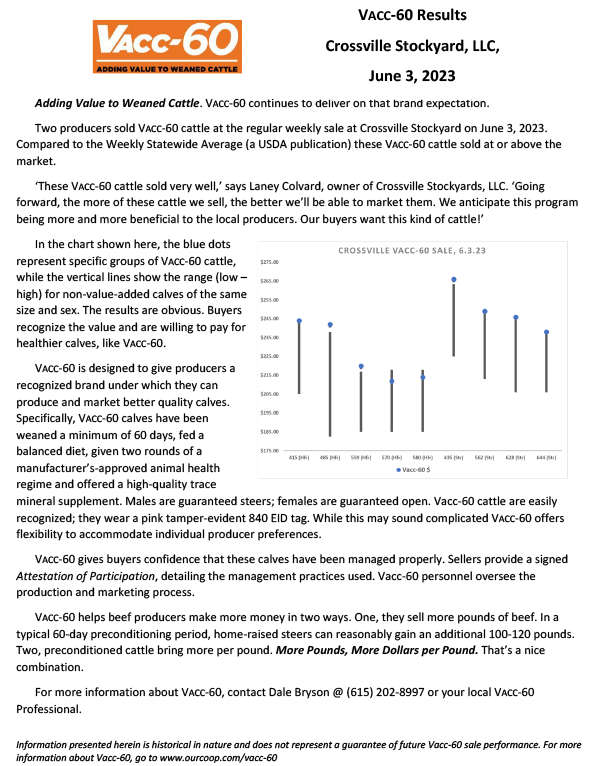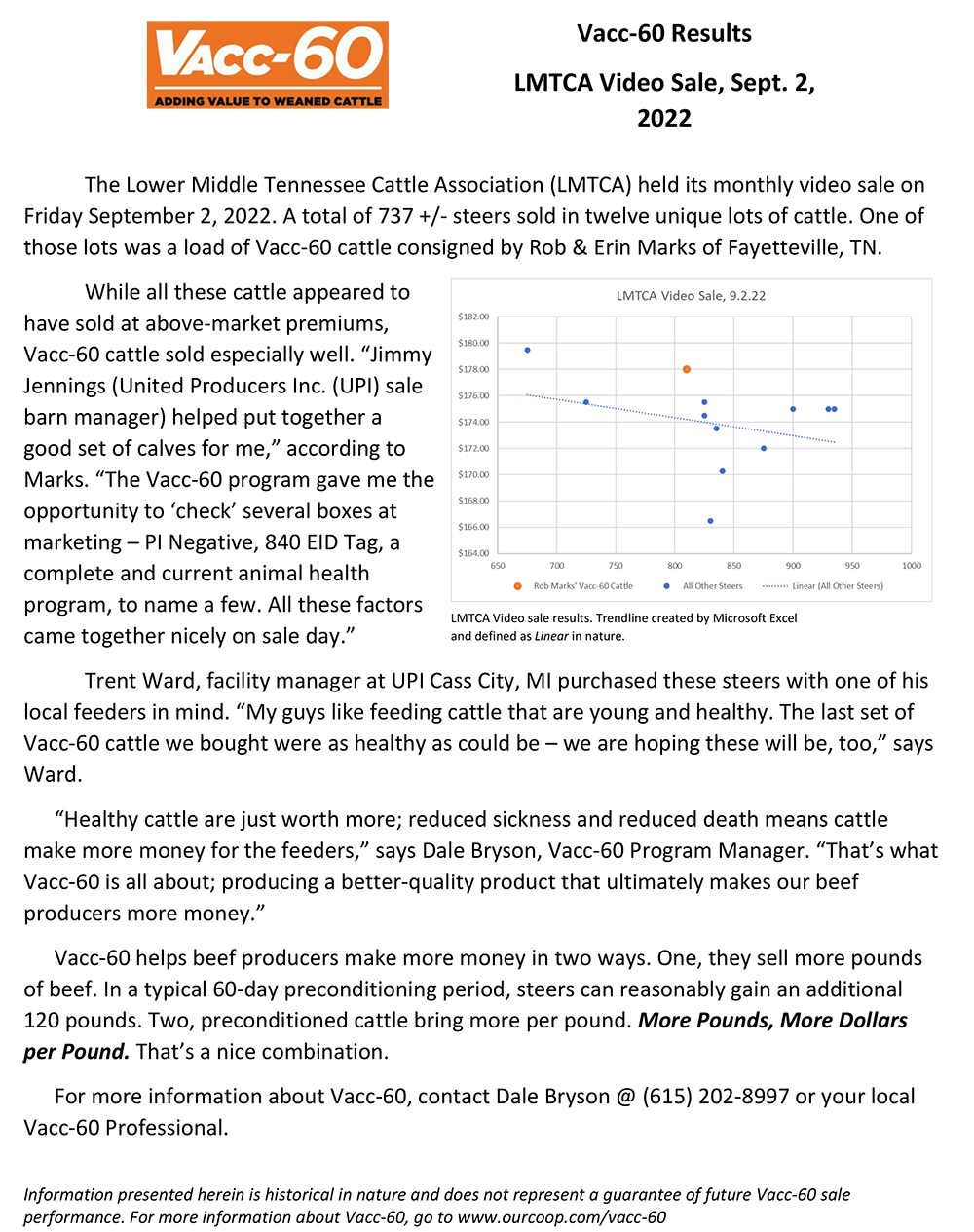Vacc-60 is a comprehensive management program designed to increase the farm-gate value of weaned calves. This program will leverage the resources of Cooperative Research Farm, Purina Animal Nutrition Center, Tennessee Farmers Cooperative, United Producers Inc. and various feed and animal health partners to bring to market the latest advances in animal care and produce the best quality product at a competitive price.
Vacc-60 includes Management, Animal Health, Nutrition, Marketing, Credit and Risk Management components designed to produce top-shelf low risk cattle, while offering multiple options to accommodate producer preferences. These cattle will be offered in a variety of options to the marketplace.
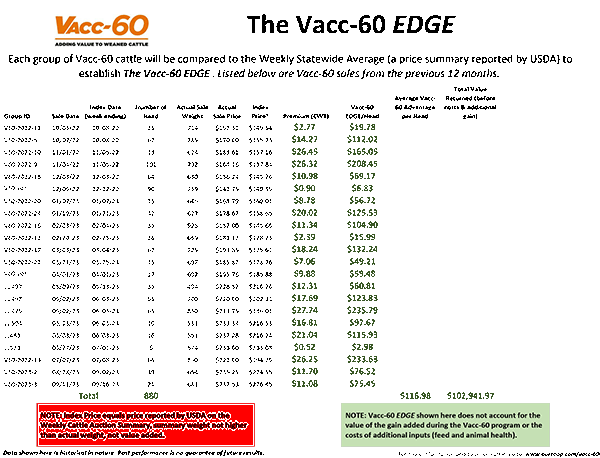
VACC-60 MANAGEMENT
- Purchased calves must be owned by seller a minimum of 60 days; home-raised calves must be weaned at least 60 days.
- Calves must be either naturally polled or de-horned to a length of 2 1/2” or less.
- Male calves must be castrated (two testicles removed) and completely healed (knife castration recommended). If castration is done by banding method, the scrotal sac with both testicles must have fallen off prior to sale.
- All female calves will be guaranteed open.
- If bred heifers or bulls (one or more testicle still present) are found and verified by a veterinarian within 30 days of the sale, $200 per head plus vet fees will be paid by the seller to the buyer of the cattle. Calves must retain the approved sale tag for the guarantee to be valid.
- All calves must be vaccinated and dewormed according to one of the prescribed animal health protocols. Calves will be identified with an 840 EID tag.
- An Attestation of Participation must be completed, signed and presented prior to delivery of the certified cattle. Documentation must be provided verifying
A. Lot No/Serial No and Expiration Dates of the animal health products used
B. Nutrition program fed.
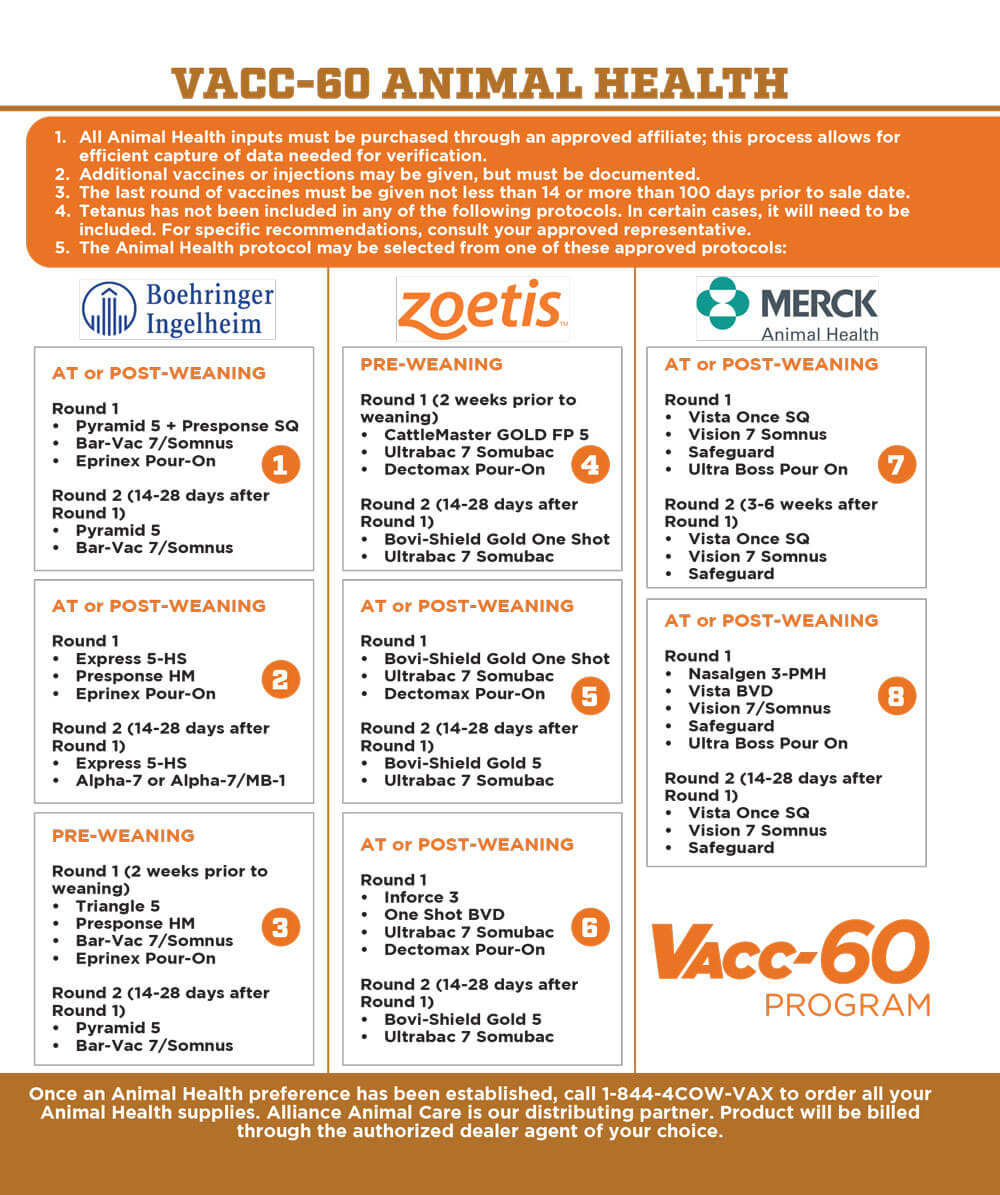
VACC-60 NUTRITION REQUIREMENTS
1. All cattle must be bunk-broke and acclimated to feed. The diet must be nutritionally complete, balanced to meet protein, energy, major mineral, trace mineral, vitamins, and roughage requirements.
2. Producers can feed any approved feed in accordance with ProTrition approved guidelines.
3. The approved feed must meet the following guarantees (on an As-Fed basis)
- Crude Protein (CP) 12 – 16 %
- Acid Detergent Fiber (ADF) 12—25%
- Net Energy Gain (NEg) .38—.45 Mcal/lb.
4. Program cattle must be offered a qualifying free choice mineral and/or a qualifying stress tub. No other salt should be offered. Qualifying products are:
Mineral
Any ‘Supreme’ named Co-op Mineral
Any ‘Availa 4’ named Purina Mineral
Tub
Any ‘Rational-Lyx’ named Co-op Tub
Purina Stress Tub #0048950
Purina Wind & Rain AS4 Availa 4 Tub #006270
5. The feed program must include RumensinTM or Bovatec.®
6. For best results, we recommend feeding the approved feed, as needed, to produce animals with Body Condition Score (BCS) between 5 and 6 (on a scale of 1 to 9).
7. Purchase of qualifying products must be verified by providing an appropriate receipt.
8. For more guidelines on the nutritional requirement, please see your qualified dealer representative.
9. At least once during the 60-day program, an approved representative must visit the farm to gather details needed for the Attestation of Participation.
Purina®-approved feeds are backed by over a century of continuous research. The force behind our quest for greatness is a talented group of Ph.D. nutritionists and veterinarians.
Together, they have conducted more than 24,000 research studies in fields across the country and registered over 125 patents.
Co-op–approved feeds are designed based on the most current information from refereed journal publications
as well as Cooperative Research Farm (CRF) proprietary information.
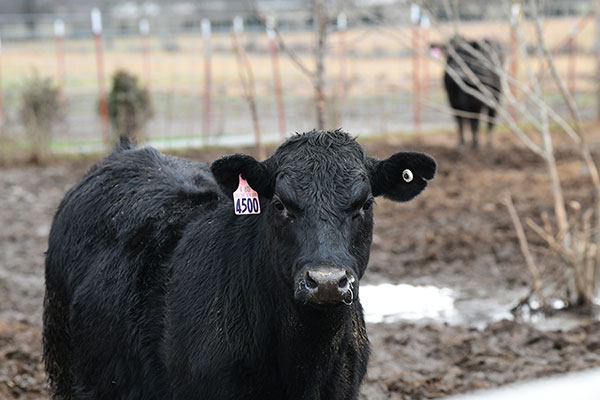
VACC-60 MARKETING
United Producers, Inc (UPI) has buyers for low-risk cattle such as Vacc-60 program cattle. Once cattle are enrolled in the program, UPI will initiate discussion with enrollees to discover marketing preferences, suggest alternatives (when available) and assist in every possible way to ensure the cattle bring their true value. Cattle can be sold at local UPI barns, sold directly off the farm, included in UPI video sales or sold at any other local sale barn. In any event, UPI is very interested in bidding on and buying these cattle.
VACC-60 CREDIT
With the Vacc-60 program we can handle all your credit needs. UPI has a full service credit shop. Like any other lender, UPI will offer competitive rates on the initial purchase of feeder cattle, to qualified accounts.
The local dealer will offer affordable financing options on the consumables through Co-op Financial Solutions (CFS), where applicable.
VACC-60 SALE-PRICE RISK MANAGEMENT
As one of the nation's largest livestock marketing agents, UPI has relationships with many of the countries largest feeders and packers. UPI markets both feeder cattle and fat cattle. They’ve always got a home for these low-risk cattle.
UPI offers sales price management that can utilize both contracts and options to produce a variety of sales price optimization models.
Vacc-60 Video Testimonials:
Testimonial
Vacc-60 Testimonial - James Monroe Davis
Learn more about Vacc-60 at https://www.ourcoop.com/vacc-60 ...
Vacc-60 Testimonial - Rob & Erin Marks
Learn more about Vacc-60 at https://www.ourcoop.com/vacc-60 ...
- Frequently Asked Questions
- General Questions
- Management Questions
- Feed Questions
- Animal Health Questions
- Financial Considerations
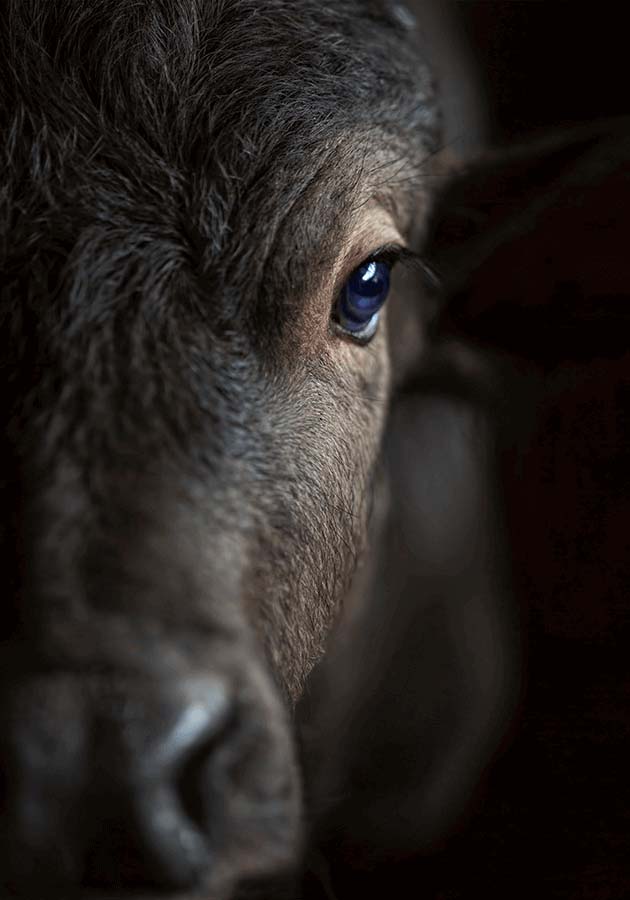
Vacc-60 Frequently Asked Questions
We hope this section answers any questions you may have.
Don't see what your looking for? Please submit your question and we will be happy to answer it for you.
General
Why should I participate in Vacc-60?
Vacc-60 represents an opportunity for beef producers to
- produce more pounds of beef and
- sell their beef for more dollars per pound.
This is accomplished by producing a better-quality product.
What is the bottom-line value of Vacc-60?
The value of Vacc-60 is that producers can produce more pounds of beef (cattle can very reasonably average gaining 2.0 lbs/head/day in a 60-day preconditioning program) and that buyers will typically pay more per pound for healthier cattle, such as Vacc-60 calves.
What is the cost to enroll in Vacc-60?
There is no enrollment cost associated with the Vacc-60 program. The only cost is for the products used, such as feed, animal health, program tags, etc.
How do I enroll my cattle in Vacc-60?
Contact your local Vacc-60 professional for an enrollment form. They will help you decide on an animal health option and assist in developing a feed recommendation. Once the enrollment form is processed, the entire process begins.
Management
Is Vacc-60 for home-raised or purchased calves?
Both home-raised and purchased calves can qualify as Vacc-60 calves, assuming all other requirements are met.
Why does Vacc-60 require calves to be weaned for 60 days?
Buyers prefer 60-day weaned calves over 45-day weaned calves. Vacc-60 is leading the way in setting the standard for 60-day preconditioned programs in this area. Additionally, the producer can expect efficient gains in the final 15 days of the Vacc-60 program.
Why do you require an 840 EID tag for Vacc-60?
The 840 EID is the only United States Department of Agriculture (USDA) officially approved means of permanent identification. Some states (Michigan, for example) require all cattle entering that state to wear the 840 EID tag. With the 840 EID tag, Vacc-60 cattle will have credentials to go anywhere in the US, providing an additional marketing opportunity.
Do male calves have to be castrated to be sold as Vacc-60 cattle?
Yes.
What if the buyer finds bull calves?
Male Vacc-60 calves are marketed as steers. If a bull (or stag) is found within 30 days of the sale, the buyer has the option to charge the grower a $200 fee, plus veterinarian charges to remedy the situation.
Do you require heifers to be given a shot of Lutalyse®?
Heifers do not have to be given Lutalyse®. However, they are promoted as open heifers. It is the growers’ responsibility to assure they are open. Lutalyse® is but one means to that end.
What if the buyer finds bred heifers?
Female Vacc-60 calves are marketed as open heifers. If a bred heifer is found within 30-days of sale, the buyer has the option to charge the grower a $200 fee, plus veterinarian charges to remedy the situation.
Feed
What are the goals of the feed component of Vacc-60?
The goal of Vacc-60 is to produce healthy cattle that are prepared for the next phase of production. From a feed standpoint, we want cattle to be bunk broke, which means that they are accustomed to eating feed from a feed bunk. To accomplish this, we need a balanced diet. Coincidentally, when we utilize a balanced diet, the grower (and his cattle) realizes efficient, affordable gains.
Does Vacc-60 require I feed the most expensive Co-op feed?
No. Vacc-60 has nutritional requirements, not specific product requirements.
What feeds do not qualify for Vacc-60?
Unfortified, low energy feeds do not qualify for use in Vacc-60. By design, Vacc-60 cattle are to be fed a complete and balanced diet, one that is balanced for protein, energy, fiber, major minerals, trace minerals and vitamins. For more specifics, and how they may be best implemented on your farm, please consult your local Vacc-60 professional.
Why does Vacc-60 require a high-priced free choice mineral (or tub)?
Mineral nutrition is very important in producing healthy cattle. Stressed cattle, such as weaned calves, are typically trace mineral deficient AND have higher trace mineral requirements. Chelated (also known as organic or proteinated) minerals are more easily digested and absorbed, thus are better at meeting the stressed calves’ trace mineral needs. By doing a better job of providing the appropriate trace minerals in the diet, the vaccines we give are more effective. In short, providing better trace mineral nutrition to Vacc-60 cattle will produce healthier cattle.
Animal Health
How were the Vacc-60 Animal Health protocols developed?
We invited animal health companies to recommend their best programs. Each company (Boehringer Ingelheim, Zoetis, and Merck) gave us their recommendations. Further, when we described our distribution process(es), they assured us that they will stand behind the health of Vacc-60 cattle, when their specific programs are followed.
Can substitutions be made in animal health protocols?
In some cases, substitutions can be made. Check with your local Vacc-60 professional. In any event, we intend for all animal health products used (on a specific group of calves) to be from one brand/family.
Do I have to go through all eight animal health protocols?
No. We have listed eight available options. You choose the one option you like best and follow that one. To make life simpler, all producers need to remember is which numbered protocol they use.
Why does Vacc-60 require two rounds of vaccines?
Vacc-60 is designed to produce healthier calves. By giving an initial dose followed by a booster at the prescribed time, we get better immunization and thus healthier cattle. Our goal is to produce top-performing cattle that buyers will seek and be willing to pay for.
Why does the last vaccine have to be given not less than 14 or more than 100 days prior to shipping Vacc-60 cattle?
We want Vacc-60 calves’ vaccinations to be current. Cattle need a long enough period to mount an effective immune response, and not so long that the immune response begins to wane. Hence that statement that the last shot will have been not less than 14 or more than 100 days prior to sale. A current vaccination status implies healthier cattle.
Does Vacc-60 require Tetanus vaccine(s)?
Vacc-60 does not require Tetanus. If male calves are castrated as part of Vacc-60, producers will likely consider adding Tetanus to the protocols. For those recommendations, please see your local Vacc-60 Professional. If Tetanus has been given, we will document that in the associated paperwork.
Does Vacc-60 require Pink-Eye vaccine(s)?
No, Vacc-60 does not require Pinkeye. If you choose to include Pinkeye, we will document that in the associated paperwork.
Financial Considerations
What is the bottom-line value of Vacc-60?
The value of Vacc-60 is that producers can produce more pounds of beef (cattle can very reasonably average gaining 2.0 lbs/head/day in a 60-day preconditioning program) and that buyers will typically pay more per pound for healthier cattle, such as Vacc-60 calves.
How are Vacc-60 cattle sold?
Vacc-60 cattle can be sold through various channels. For larger loads, video sales are a great option. For smaller lots, Vacc-60 cattle can be sold straight off the farm. In some instances, Vacc-60 cattle will be sold at the regular weekly sale-barn. Other times, Vacc-60 cattle will be co-mingled and sold at special sales. In any event, by registering Vacc-60 cattle ahead of time, we create visibility and assist the producers in getting handsomely rewarded for their efforts. The producer is in no way obligated to sell Vacc-60 cattle in any certain form or fashion. We will, however, make every effort to see that the buyers are familiar with and know the value of Vacc-60 cattle.
Who can qualify for financing the purchase of feeder cattle?
In some cases, cattle can be purchase and financed through United Producers, Inc. (UPI.) UPI has certain requirements that must be met. For more information, please consult your local UPI representative or your local Vacc-60 Professional.
How can I finance the animal health and feed for Vacc-60?
In many cases, the consumable products (feed and animal health specifically) can be financed through the local dealer. Consult your local Vacc-60 professional for more details.
What is Sale-Price Risk Management and how does it work?
Sale-Price Risk Management is an insurance policy on the sale price of your cattle. While this can be an extremely valuable product, it can get complicated. For more details on Sale-Price Risk Management, please consult your local United Producers Inc. representative.
